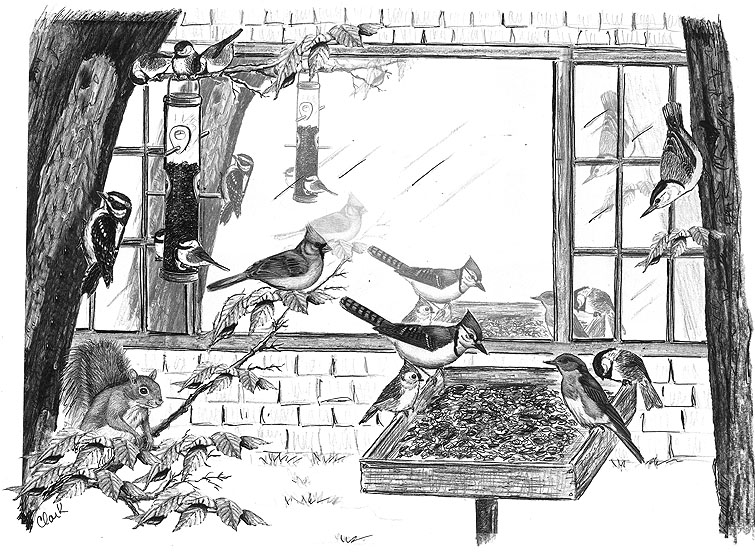
Dear Bird Folks,
This little bird in the attached photo hit my slider window this morning. Can you tell me what kind of bird it is? Also, how can I prevent it from happening again?
– Tony, Falmouth, MA
It’s a catbird, Tony,
The bird in your photo is a Gray Catbird. It’s actually a baby (fledgling) and was probably enjoying its first taste of freedom…until your slider got in its way. How do I know it’s a baby? Its feathers are dull and disheveled, not slick and smooth like the adults’ plumage. But the real key to its age is found along the edges of the beak. The mouths of most nestlings are brightly colored (typically yellow, but also red and orange). It is thought the intense coloring helps the parents know which baby needs to be fed and where they (the parents) should put the food. (Is that actually a problem? I may not have been the best parent in the world, but even I knew where the food was supposed to go.) For the first week or so after fledging, many young birds still have a trace of yellow on their “lips.” They look as if they have just finished eating a liverwurst sandwich, with extra mustard. (Do they still make liverwurst? Maybe I should have used a different example, but you get the picture.)
It’s hard to overestimate the problem our love of glass has created for birds. Window strikes kill nearly a billion birds each year. This puts glass right up there with other deadly hazards such as house cats, habitat destruction, pesticides and most likely, liverwurst. Glass isn’t found in nature, so it’s easy to understand why it’s such a problem. Even humans have trouble with glass…and we invented it. How many people reading this have walked into a glass door at least once in their life? You don’t have to raise your hand, we all know you have. Only, when we do it, it’s funny; with birds, not so much.
Birds have remarkable vision, so why can’t they identify and avoid windows? It’s about reflection, as windows can sometimes become mirrors. What appears to be a nice safe tree or shrub is actually the reflection of a nice safe tree or shrub. Also, this time of year many birds are seeing the world for the first time and are just learning to fly. It’s like dropping a teenage human, who has never been in a car before, into a strange city, during rush hour and telling him or her to drive. And, just to add to the confusion, some of the cars, buildings and streets are real, while others are only mirrored reflections. It’s like a bad video game.
Back in the old days, we used to attach hawk silhouettes to our windows. We thought that would scare the birds away. It was a nice gesture, but I’m not convinced they did much good. A more recent product, called “WindowAlerts” ignores the hawk outline and instead uses random shapes to warn birds. WindowAlerts come in an assortment of shapes (leaves, snowflakes, butterflies, etc.) and even though the shapes are actually irrelevant, it doesn’t stop my customers from debating which shape is the best. (If there’s a bird topic, they’ll argue about it.) The alerts are small static-cling decals which can be easily removed. What makes these decals so special, you ask? They reflect ultraviolet light, which the birds can readily detect and the glowing light warns them of potential danger. Humans, on the other hand, don’t see ultraviolet light, so we aren’t bothered by the decals (and continue to walk into sliders).
I find the decals to be helpful, but they aren’t perfect. After a year or so, their effectiveness fades and they need to be replaced. And, sometimes they don’t work at all. There was one particular window at my house that was like a black hole for birds. No matter how many decals I used, the birds kept smacking into it. So, I invented my own deterrent. I took a strip of holographic scare tape (the same stuff they use to keep birds out of gardens and woodpeckers off buildings) and attached it to a suction cup. I stuck the suction cup (and scare tape) onto the bad window and so far, so good. Plus, it makes the house look really classy (not).
Another product that helps prevent window strikes is a stick-on-the-window birdfeeder. It seems contradictory to purposely attract birds to windows, but in this case, it may be a good thing. The feeder breaks up the deadly reflection that often fools the birds. If you don’t want a feeder “on” your window, at least have them close by. Studies have shown that feeders placed within three feet of a window are the safest. Why is that? It’s because, birds (if startled by a hawk) simply can’t build up enough speed to hurt themselves. Besides, with the feeder close by, you’ll know when it’s empty and time to run out and buy more birdseed (hint, hint).
This is a tough time of year for birds vs. windows, Tony. In addition to all of the confused fledglings, scores of migrants will soon be streaming down from northern forests, and like your young catbird, they will have had little experience with our endless acres of windows. Using ultraviolet decals are helpful, but streamers of scare tape may be needed on problematic windows. Finally, if none of those things do the trick, there is one last thing you can do. Hang a few slices of liverwurst around and they will most certainly keep the birds away…as well as everyone you know.